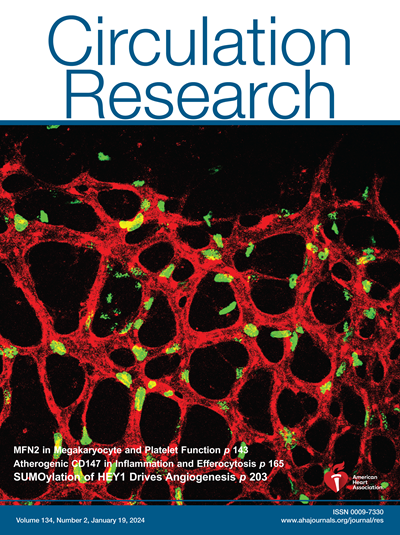骨髓特异性STING-YBX1相互作用减轻深静脉血栓的凝血。
IF 16.2
1区 医学
Q1 CARDIAC & CARDIOVASCULAR SYSTEMS
引用次数: 0
摘要
深静脉血栓形成(DVT)是心血管死亡的第三大常见原因,其特征是血管内血栓形成,常伴有炎症。尽管STING(干扰素基因刺激因子)信号通路因其在感染、细胞应激和组织中介导炎症的作用而得到广泛认可,但其在深静脉血栓形成中的复杂参与仍然是一个谜。方法在本研究中,我们利用小鼠模型研究骨髓细胞内生性STING信号在DVT进展中的作用。使用STING抑制剂和骨髓特异性STING基因缺失来评估其对血栓形成的影响。此外,我们通过生化分析探讨了STING与YBX1 (y -box binding protein 1)之间的相互作用。一种合成肽C-ST16,设计用于模拟STING抑制剂,测试其在减少血栓形成和炎症反应方面的治疗潜力。我们的研究结果表明,髓细胞内在的STING信号是DVT进展的关键驱动因素。通过特异性抑制剂或骨髓特异性STING基因缺失抑制STING,可以显著改善小鼠DVT模型中的血栓形成。此外,我们确定了STING和YBX1之间的直接相互作用,导致核易位和血栓性炎症加剧。合成的肽C-ST16可有效减少血栓形成和炎症因子表达,且不引起肝肾毒性。这些发现强调了骨髓特异性STING-YBX1信号在DVT进展过程中驱动炎症的关键作用。STING抑制剂的潜在治疗用途,特别是合成肽C-ST16,为DVT治疗提供了一种有前景的方法,为血栓性疾病的靶向抗炎治疗提供了新的见解。本文章由计算机程序翻译,如有差异,请以英文原文为准。
Myeloid-Specific STING-YBX1 Interaction Alleviates Coagulation in Deep Vein Thrombosis.
BACKGROUND
Deep vein thrombosis (DVT), the third most common cause of cardiovascular deaths, is characterized by intravascular clot formation, often accompanied by inflammation. Although the STING (stimulator of interferon genes) signaling pathway is well recognized for its role in mediating inflammation in the context of infection, cellular stress, and tissue, its intricate involvement in DVT remains enigmatic.
METHODS
In this study, we investigated the role of myeloid cell-intrinsic STING signaling in DVT progression using murine models. Both STING inhibitors and genetic depletion of myeloid-specific STING were used to assess their effects on thrombus formation. In addition, we explored the interaction between STING and YBX1 (Y-box-binding protein 1) through biochemical analyses. A synthetic peptide, C-ST16, designed to mimic STING inhibitors, was tested for its therapeutic potential in reducing thrombus formation and inflammatory responses.
RESULTS
Our results demonstrate that myeloid cell-intrinsic STING signaling is a key driver in DVT progression. STING inhibition, either through specific inhibitors or genetic depletion of myeloid-specific STING, significantly ameliorated thrombus formation in murine DVT models. Furthermore, we identified a direct interaction between STING and YBX1, resulting in nuclear translocation and heightened thrombotic inflammation. The synthetic peptide, C-ST16, effectively reduced thrombus formation and inflammatory factor expression, without causing hepatorenal toxicity.
CONCLUSIONS
These findings highlight the critical role of myeloid-specific STING-YBX1 signaling in driving inflammation during DVT progression. The potential therapeutic use of STING inhibitors, particularly the synthetic peptide C-ST16, presents a promising approach for DVT management, offering novel insights into targeted anti-inflammatory therapies for thrombotic disorders.
求助全文
通过发布文献求助,成功后即可免费获取论文全文。
去求助
来源期刊

Circulation research
医学-外周血管病
CiteScore
29.60
自引率
2.00%
发文量
535
审稿时长
3-6 weeks
期刊介绍:
Circulation Research is a peer-reviewed journal that serves as a forum for the highest quality research in basic cardiovascular biology. The journal publishes studies that utilize state-of-the-art approaches to investigate mechanisms of human disease, as well as translational and clinical research that provide fundamental insights into the basis of disease and the mechanism of therapies.
Circulation Research has a broad audience that includes clinical and academic cardiologists, basic cardiovascular scientists, physiologists, cellular and molecular biologists, and cardiovascular pharmacologists. The journal aims to advance the understanding of cardiovascular biology and disease by disseminating cutting-edge research to these diverse communities.
In terms of indexing, Circulation Research is included in several prominent scientific databases, including BIOSIS, CAB Abstracts, Chemical Abstracts, Current Contents, EMBASE, and MEDLINE. This ensures that the journal's articles are easily discoverable and accessible to researchers in the field.
Overall, Circulation Research is a reputable publication that attracts high-quality research and provides a platform for the dissemination of important findings in basic cardiovascular biology and its translational and clinical applications.
 求助内容:
求助内容: 应助结果提醒方式:
应助结果提醒方式:


